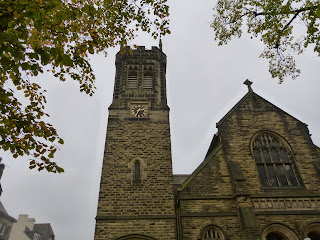So, I present Londonopoly #2 - Oxford Street
This is a journey from west to east. I am sure that an east to west journey would be just as good and you would see the same clocks (except that they would be in the reverse order).
Marks and Spencer's flagship store is at the junction with Orchard Street, with the name of the building clearly highlighted on its clock.
The building itself, as indicated by the inscription shown below, was opened in 1930.
Even grander, in fact the grandest store on Oxford Street and arguably the whole of London, is Selfridges. The shop was built in stages between 1909 and 1926, although you would never realise that today. To celebrate the 21st birthday of the store, the owners commissioned a clock. This was unveiled in October 1931 and sits above the main entrance.
The clock itself is quite impressive, but it would be lost amongst the massive façade of the shop were it not for its supporting sculpture. This is the "Queen of Time" by Gilbert Bayes (1872 - 1953), thrusting out from the building on the prow of a ship.
There is a huge amount of detail on this sculpture, much of which is not captured here. The best thing to do is visit it yourself, although I would avoid going before Christmas unless you want to be swept away in a tide of increasingly desperate shoppers.
St Christopher's Place is a lovely shopping square hidden away behind Oxford Street and reached by a narrow alleyway which is easy to miss. To help you find the place, this clock helpfully points the way.
To the east of Oxford Circus lies the more mundane timepiece on the local branch of H Samuel (note that the M&S shop next door is a different one from the one with the clock described earlier).
The next clock is at 100 Oxford Street. I have passed this clock on numerous occasions over many years, yet the time has always been just after 2 o'clock.
Across the road is a clock at the English college. This has recently been repainted, although I am not sure if the clock is a replacement or not.
So only six clocks along the entire length of Oxford Street which is a rather poor show (it is after all about a mile long, and has four London Underground stations). At a price of £300 on the popular board game, this works out at £50 per clock.
.JPG)
.JPG)
.JPG)
.JPG)
.JPG)
.JPG)
.JPG)
.JPG)
.JPG)
.JPG)
.JPG)
.JPG)
.JPG)
.JPG)
.JPG)
.JPG)
.JPG)
.JPG)
.JPG)
.JPG)
.JPG)































































